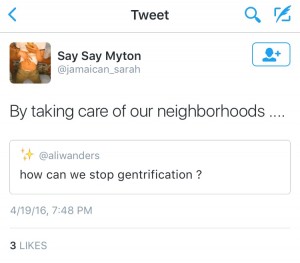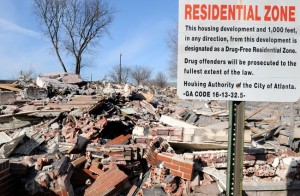When discussing gentrification, historically, it holds a negative connotation– wealthy white people move into an urban area, call it urban and low income residents are relocated and forgotten. This is the most common idea that reigns in conversations on the topic.
In a recent conversation with my mother, she asked where my boyfriend lives and I told her Old Fourth Ward. In shock, she responded to me “Fourth Ward?” and it hit me: Old Fourth Ward wasn’t always Old. The Fourth Ward my mother once lived in is not the same as the Old Fourth Ward that my boyfriend lives in today.
In that same moment I realized that it was a gentrified area. And here are the reasons why it is gentrified and ideas on how to actually be the “gentry” and include everyone in neighborhood revitalization.
Its (black) History
Atlanta neighborhood “Fourth Ward” was home of Dr. Martin Luther King and was once an elegant black neighborhood. Today, Old Fourth Ward is less than 50 percent black and pieces if it’s black history lie in its shadows.
The David T Howard building has been closed for over 20 years. Alumni have been trying to restore it, but they lack funds. This school was built with giving black kids a well rounded education in mind but the building remains, gated and vacant.
There is a new urban fantasy that now defines O4W and hides the neighborhood’s history.
Relocation of black residents
For most of the 20th century, Atlanta was known for its public housing. The very housing projects that were built to aid low income communities have since been demolished. Herndon homes off Northside drive, was demolished in 2010 and close to 250 families were relocated.
The demographics of Atlanta have changed drastically in the last five years. According to Creative Loafing, Atlanta was named one of the top 10 cities where gentrification is growing the fastest in 2015. The last census showed a 12% dip in the black population in Atlanta.
Recent Rapid Changes
Much of the change to the look of Old Fourth Ward was orchestrated by Gravel and The Atlanta BeltLine Redevelopment Plan. Adopted in 2005, the municipal revitalize the older in-town neighborhoods and make them attractive to people seeking a more urban setting.
In addition to the Beltline, Ponce City Market was a $180 million project that took six years to come to fruition.
The majority of these changes are not bad for the community, which suggests that gentrification isn’t all bad. In the end, change is inevitable and Old Fourth Ward is one of Atlanta’s most desirable neighborhoods.

However, when you have people criticizing the people who lived there previously for not being able to do things, such as art on the beltline or funding something like Ponce City Market, that require resources, kick them out and then call it an “urban Renaissance” it seems bad.
However, in the neighbirhood revitalization process, maybe we should look at the questions. What kinds of neighborhoods we want to create. How do we preserve and expand affordable housing? How do we improve neighborhood while including the existing residents?
Let’s figure out how to provides resources for the residents of these urban areas and integrate. Reinstate housing projects in the modern day.

Really It’s very helpful. Thank You for sharing your good information. best headphones for girlfriend